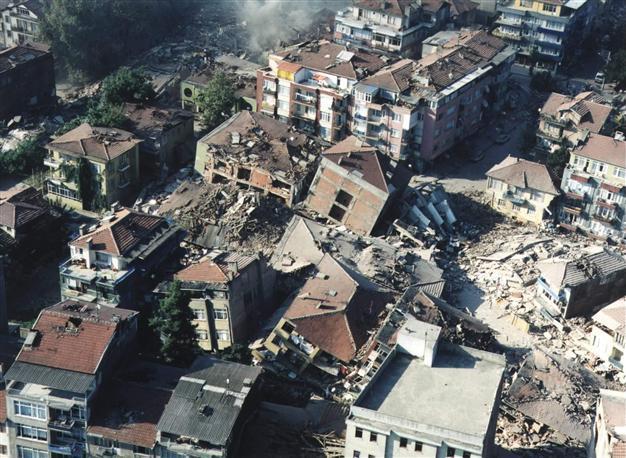Victims of Marmara earthquake remembered on 15th anniversary
KOCAELİ – Doğan News Agency

The 1999 quake, which had a magnitude of 7.4, killed a total of 17,480 people. DHA Photo
Commemoration events have been held across Turkey’s northwestern Marmara region on the 15th anniversary of the country’s worst seismic disaster in recent history, which killed over 17,000 people.
People threw flowers into the sea and left a wreath at the earthquake monument at 3:02 a.m., the exact time of the catastrophe, in the town of Gölcük on the southern shore of the Marmara Sea, which was the epicenter of the quake.
The 1999 quake, which had a magnitude of 7.4, in Turkey’s most industrial and densely populated region, killed a total of 17,480 people. Over 285,000 buildings were damaged and 600,000 people were left homeless by the 45-second quake, which left social and economic wounds that took years to heal.
Science, Industry and Technology Minister Fikri Işık, Bursa Governor Münir Karaloğlu, ruling Justice and Development Party (AKP) Kocaeli deputy İlyas Şeker, Gölcük Mayor Mehmet Ellibeş, and the National Earthquake Monitoring center’s head, Dr. Doğan Kalafat, also attended the ceremonies.
Kalafat said young people had forgotten the earthquake and its disastrous results and called for the further educating of youths against the risk of earthquakes.
“Young people have forgotten the quake. We have to raise awareness about this issue,” he said.
Kalafat recalled that the conditions of buildings, rather than earthquakes, were the cause of earthquake deaths in Turkey. “People should take earthquakes as a natural incident that will take place, such as snow and rain, and prepare their houses accordingly,” he said.
Ellibeş also advised people to pay attention to the strength of the building, rather than the aesthetics of the apartment, when buying a house. He also said they were afraid of “tired” buildings that survived the earthquake and have since remained in use.
“What scares us are the buildings that survived the earthquake and are still being used. We all have to make a decision about these buildings. We have to apply to the necessary institutions and test whether they can survive further quakes,” he said.
Meanwhile, speaking during another ceremony on Aug. 17, Kandilli Observatory President Prof. Dr. Mustafa Erdik said the possibility of a serious earthquake taking place in Istanbul was 3 percent annually.
He said they predicted that around 30,000 buildings would be crumble if a sizable earthquake hit Istanbul.
Responding to a question on whether the coal gas leak under the Marmara Sea could be a sign of quake, Erdik said the leak had been happening for many years now and was not a sign of a quake.
“The leak was first seen after the 1999 quake. We are monitoring this and it is not a new phenomenon. It is not a sign of a quake. We know that an earthquake will take place regardless of the gas leak. It does not affect the future earthquake possibility,” Erdik added.
